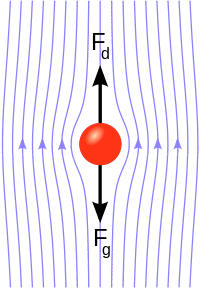
Back جريان ستوكس Arabic Stokesovo strujanje BS Schleichende Strömung German Flujo de Stokes Spanish جریان استوکس FA Écoulement de Stokes French משוואות סטוקס HE Flusso di Stokes Italian 크리핑 유동 Korean Stokes akışı Turkish

Stokes flow (named after George Gabriel Stokes), also named creeping flow or creeping motion,[1] is a type of fluid flow where advective inertial forces are small compared with viscous forces.[2] The Reynolds number is low, i.e. . This is a typical situation in flows where the fluid velocities are very slow, the viscosities are very large, or the length-scales of the flow are very small. Creeping flow was first studied to understand lubrication. In nature, this type of flow occurs in the swimming of microorganisms and sperm.[3] In technology, it occurs in paint, MEMS devices, and in the flow of viscous polymers generally.
The equations of motion for Stokes flow, called the Stokes equations, are a linearization of the Navier–Stokes equations, and thus can be solved by a number of well-known methods for linear differential equations.[4] The primary Green's function of Stokes flow is the Stokeslet, which is associated with a singular point force embedded in a Stokes flow. From its derivatives, other fundamental solutions can be obtained.[5] The Stokeslet was first derived by Oseen in 1927, although it was not named as such until 1953 by Hancock.[6] The closed-form fundamental solutions for the generalized unsteady Stokes and Oseen flows associated with arbitrary time-dependent translational and rotational motions have been derived for the Newtonian[7] and micropolar[8] fluids.
- ^ Kim, S. & Karrila, S. J. (2005) Microhydrodynamics: Principles and Selected Applications, Dover. ISBN 0-486-44219-5.
- ^ Kirby, B.J. (2010). Micro- and Nanoscale Fluid Mechanics: Transport in Microfluidic Devices. Cambridge University Press. ISBN 978-0-521-11903-0. Archived from the original on 2019-04-28. Retrieved 2010-01-15.
- ^ Dusenbery, David B. (2009). Living at Micro Scale. Harvard University Press, Cambridge, Massachusetts ISBN 978-0-674-03116-6
- ^ Leal, L. G. (2007). Advanced Transport Phenomena: Fluid Mechanics and Convective Transport Processes.
- ^ Chwang, A. and Wu, T. (1974). "Hydromechanics of low-Reynolds-number flow. Part 2. Singularity method for Stokes flows" Archived 2012-03-07 at the Wayback Machine. J. Fluid Mech. 62(6), part 4, 787–815.
- ^ Brennen, Christopher E. "Singularities in Stokes' Flow" (PDF). caltech.edu. p. 1. Archived from the original (PDF) on 10 September 2021. Retrieved 18 July 2021.
- ^ Shu, Jian-Jun; Chwang, Allen T. (2001). "Generalized fundamental solutions for unsteady viscous flows". Physical Review E. 63 (5): 051201. arXiv:1403.3247. Bibcode:2001PhRvE..63e1201S. doi:10.1103/PhysRevE.63.051201. PMID 11414893. S2CID 22258027.
- ^ Shu, Jian-Jun; Lee, J.S. (2008). "Fundamental solutions for micropolar fluids". Journal of Engineering Mathematics. 61 (1): 69–79. arXiv:1402.5023. Bibcode:2008JEnMa..61...69S. doi:10.1007/s10665-007-9160-8. S2CID 3450011.
